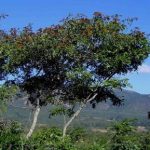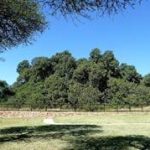TREE LIFE
March 2010
MASHONALAND CALENDAR
Sunday, March 21st: Bally Vaughan Sanctuary
By kind permission of Sarah Carter, the main outing for March will be to the Bally Vaughan Sanctuary.
It must be many years since the Tree Society last visited Bally Vaughan. I personally last went there nine years ago, and we found some nice rocky and riverine vegetation, rather like that of Domboshawa and Ngomakurira.
The entrance fee is $4 per person. Sarah has agreed that we can all drive right up to the restaurant area, park beyond that, do our walk and then use her verandah facility for lunch so neither chairs nor tables would have to be brought. There is a snack menu available if anyone would like to use their kitchen (burger $3); otherwise bring a packed lunch as usual.
“Saviour” tree turns scourge in Kenya
A tree introduced to Kenya to combat desertification has itself become a problem, invading farmland and damaging farmers’ livelihoods.
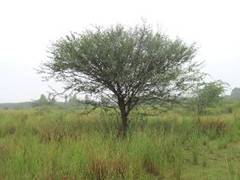
Prosopis juliflora, also known as devil tree. Photo: Wikipedia
Prosopis juliflora, known as the ‘devil tree’, in some areas, was introduced from Latin America to semi-arid districts of Kenya by nongovernmental organisations in the 1980s. It was selected because of its ability to survive in dry environments and for its expansive root system, which helps bind soil and prevent erosion.
Now P. juliflora is the target of a planned government control programme after research by Gabriel Muturi of the Kenya Forestry Research Institute (KEFRI), published in April last year, found that up to 27 million hectares of land are at risk from the plant.
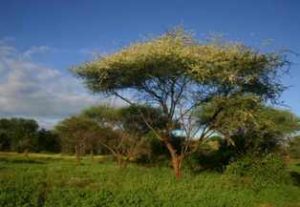
Acacia tortilis is being threatened by Prosopis juliflora in northwest Kenya. Photo: Burt Wursten. Source: Flora of Zimbabwe
The study, carried out in arid Turkana district in northwest Kenya, also showed that a local species of acacia tree, Acacia tortilis, has declined by over 40 per cent in some areas possibly because P. juliflora is displacing it.
FarFarmers in the Baringo district of Kenya’s Rift Valley province have sued the government for millions of Kenyan shillings for loss of grazing fields and arable land caused by the alien tree’s invasion. The farmers say they have lost animals, which died because they were unable to eat when their teeth fell out after feeding on the shrub.
“The government is working round the clock to come up with a policy on management of the species,” said Raphael Mworia, spokesperson for the Kenya Forestry Service (KFS). “A policy paper detailing where it can be planted, when and in what numbers is being worked on and soon the government will be able to release the guidelines to the public,” added Mworia.
Meanwhile the KFS is training farmers on how to live with the shrub, by using its pods for fodder and stems for firewood timber and charcoal. “Pastoralists must now start making use of the benefits that come with the species instead of looking at the negative aspects of it all the time,” said Mworia.
Mworia added that increased use of P. juliflora for charcoal would save the over-exploited acacia species from being used for this purpose.
[Adapted from the original by Maina Waruru and posted on https://www.scidev.net/en/sub-saharan-africa/news/ in November 2009]
TREE LORE – THE ASH
• Placing ash berries in a cradle prevents the child from being traded for a changeling.
• It is an old belief that tools with handles made of ash enable more work to be done than by tools with handles made of other kinds of wood.
• “Ash courts the flash.” Ash trees were believed to attract lightning. Like the oak, they were used in European fire and rain-making ceremonies.
• It was believed that so much hostility exists between adders and ash trees that if an adder is placed in a circle of ash leaves broken only by fire, it would go through the fire to escape.
• Irish emigrants to America carried pieces of ash with them because its wood was a charm against drowning.
• In England, naked children were passed through cleft pollard ashes before sunrise as a cure for rupture.
• A Yule log of ash is said to ensure the future prosperity of the family.
In Dorset, the number of leaflets on an Ash leaf could be used to predict the romantic future for girls.
An even Ash leaf in my hand
The first I meet shall be my man
The even Ash leaf in my bosom
The next I meet shall be my husband.
[I am certain there are just as many beliefs about our local trees as the European ones I am featuring in this series, and I would like to put together a series on the myths surrounding local trees. I would be grateful therefore if readers could send me any lore about local trees they may be privy to.
-Ed.]
Margaret (Meg) Patton Childes
(née Jamieson)
Margaret Patton Jamieson was born on 2 July 1924 in the little town of what was then called Potgietersrus, in the South African Transvaal. She was the younger daughter of Andrew Patton Jamieson, a Scottish emigrant, and Charlotte Harding, one of the many Hardings who hailed from the town of Harding in Natal. Her siblings were a sister, Joan, and brother, Phillip. She had 22 first cousins.

Margaret Childes
Tiring of the droughts and farming problems around Pietersburg, the Jamieson family packed their few possessions into a Ford motorcar and drove up to Southern Rhodesia. They initially farmed near Bindura but soon looked for a cooler, wetter climate, and eventually settled at Theydon, near Marondera. Their farm was called Dunsappie, named after a small loch in Edinburgh, her father’s home town. As with so many of the early farmers, they survived good and bad years: crop failures, drought, locust plagues, and crop-raiding baboons. As her elder sister and brother were sent off to boarding school, Margaret (Meg to family and friends) was frequently alone and she used to tell of her long walks and explorations of the many kopjes on the farm, always in the company of her faithful dogs.
Meg was educated at Marandellas High and later at Girls’ High School in Salisbury. She was awarded a Junior Beit Scholarship, which enabled her to sit her Matric examinations, where she excelled in geography and botany. The Second World War intervened and with the death of her brother Pip in 1944, she was forced to give up any idea of university and earn her living. Her first job was with the Treasury Department, where she earned the enormous sum of £11 per month. She and Joan and two other friends shared a small flat, and their only transport was bicycles.
In 1954, she married Lieutenant (later Major) Edgar Davey Childes in what was quite a society wedding. There were over 300 guests including the Prime Minister. Meg refused to have her children grow up in a flat in surburbia so she and her husband took out a (very) long-term loan and bought 14 acres of land in Quinnington, Borrowdale. Their friends thought they were mad living right out “in the sticks” where the only access was a dusty/muddy quagmire of a road. But Meg could indulge her farming instincts, and she developed a huge vegetable garden and fruit orchard as well as a wide variety of flowers and interesting plants, such as aloes and cycads. Being a keen botanist, she knew the Latin names of many plants, and passed these on to her children, along with the enjoyment of long evening walks accompanied by the dogs and an appreciation of wild life. In addition to being a keen gardener, Meg also spent hours making marmalades, jams, chutneys and other preserves.
For several years in the 1970s she ran a small hardware business in Chisipite, and eventually moved back into public service in 1976. She initially worked in the Registry at Research and Specialist Services, and later transferred to Police Headquarters, where she became the Registry Supervisor – a position of great responsibility. After retiring from government in the early 1980s, Meg then worked for an estate agent until she finally retired in 1994. She still kept very busy and worked hard for several committees: the Aloe and Cycad Society, the Harare Garden Club, the Rose Society and the SPCA. She was a very ardent and interested supporter of the Tree Society.
Her knowledge of plants, her love of animals and her willingness to help others have been an inspiration to her family and friends.
Famous Trees of Africa
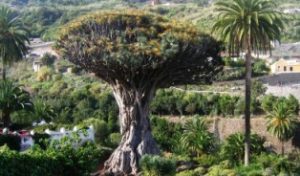
Dracaena draco, dragon tree on the Canary Islands. Photo: Wikipedia
Icod de los Vinos is a small town in the Canary Islands, a Spanish archipelago off the northwest coast of mainland Africa. For more than a hundred years, a dragon tree (Dracaena draco) has always been a local tourist attraction of the place. In fact, this interesting looking tree has become the symbol of Icod. Although no study has yet confirmed the age of the tree, it is believed to have been standing there for thousands of years. Indeed, in Spanish the tree is referred to as Drago Milenaryo. The tree was described and illustrated in the Atlas Picturesque (1810) by German naturalist and explorer Alexander von Humboldt.


